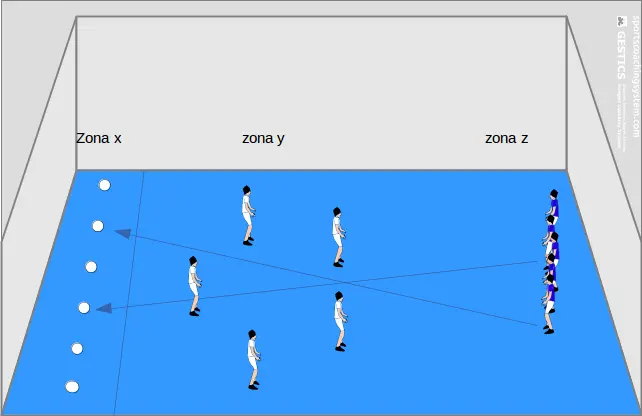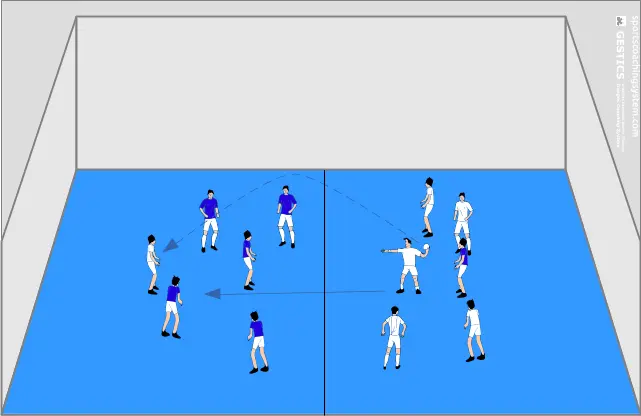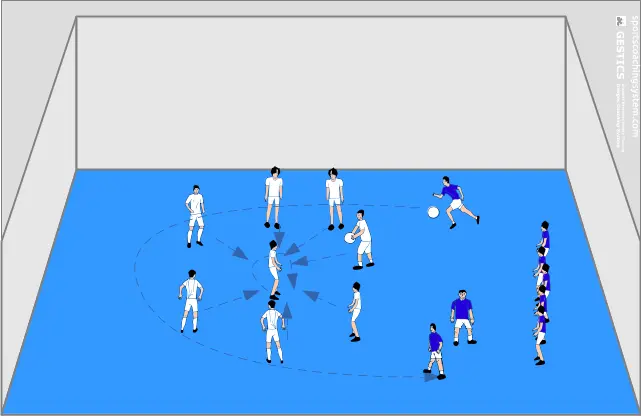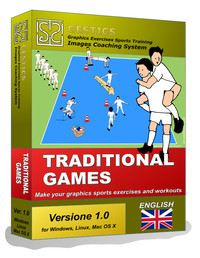MOVEMENT AND SPORTS GAME FOR CHILDREN - N. 0024 - steal the balls

GRAPHICS MADE WITH THE SOFTWAREGESTICS SPORTS
HTTPS://WWW.SPORTSCOACHINGSYSTEM.COM
Type and Action
Typology: movement and sports game for children, exercise ball fight games
Objective: basic physical-motor activity, rugby, running, dodging, coupling and motor combination skills, orientation skills, motor anticipation skills, dexterity, general speed, absolute strength
Action:
Technical Sheet
Group/Team: in teams
Ages: 3-7 years old, 7-11 years old
Departure
arranged as described, one team on the field and one behind a line off the field;, 2 teams, minimum 4 players per team. The field about m. 20x20, divided into 3 zones
Execution
the white team is in the Y area of the court, the black team is in the Z area of the court. On the opposite side of the field, in zone X there are several balls. At the signal of the animator, the members of the black team crossing the Y zone must go to the other side of the field, catch no more than one ball each and bring it to their own zone. White team members must prevent the blacks from stealing balls by holding them, or hindering them until time is up. If a player manages to steal a ball he can start again to steal another. The team that manages to steal the most balls wins
RULES: forbidden to hit each other, but only to hinder or hold back
GOAL: steal the most balls in a certain time
SCORING: 1 point for each steal
VICTORY: the team with the most points wins
Variants
Vary the number of members per team: e.g. who steals 10 members, who keeps 5 and vice versa
Advice
Be careful that the game does not become violent
Materials
about 7-8 balls
MOVEMENT AND SPORTS GAME FOR KIDS - No. 0023 - I run, you dodge the ball

GRAPHICS MADE WITH THE SOFTWAREGESTICS SPORTS
HTTPS://WWW.SPORTSCOACHINGSYSTEM.COM
Type and Action
Typology: exercise and sports game for children, running games, throwing and catching the ball
Objective: basic physical-motor activity, football, basketball, running, throwing, dodging, motor matching and combination skills, orientation skills, motor anticipation skills, dexterity, general speed
Action: , control, dribble
Technical Sheet
Group/Team: in teams
Ages: 7-11 years, 3 - 7 years
Departure
arranged as described, the black team inside the field, the white team outside, in 2 rows;, 2 teams, minimum 4 players per team. The field about m. 10x20
Execution
the members of the white team are arranged in two lines. A front row member of the white team throws the ball onto the court where the black team is and then takes a lap (of the court or a designated course). A member of the second row of the white team simultaneously with the throwing of the ball by his partner enters the field of the black team. The black team members catch the ball and, without running, but making passes, must hit the white team member who enters their court in the time that the other white team member completes the round. When a pair from the white team has finished, they move to the end of their line and start another pair. Eventually the teams switch roles
RULES: members of the black team cannot run
PURPOSE: The player of the white team who enters the court must not be hit until his partner has finished the round
SCORING: 1 point for each component that achieves the goal of the game
VICTORY: the team with the most points wins
Variants
Change the route.
Vary the type of ride when performing the lap.
Running dribbling or kicking a ball.
Inside the blacks' field, kick the ball with your feet instead of your hands
Advice
Materials
1 ball
MOVEMENT AND SPORTS GAME FOR CHILDREN - No. 0022 - the spies

GRAPHICS MADE WITH THE SOFTWAREGESTICS SPORTS
HTTPS://WWW.SPORTSCOACHINGSYSTEM.COM
Type and Action
Typology: movement and sports game for children, exercise, run games, throwing and catching the ball
Goal: basic physical-motor activity, basketball, throwing, grabbing, running, coupling and motor combination skills, space-time and dynamic differentiation skills, motor anticipation skills, dexterity, general speed
Action:, pass
Technical Sheet
Group / Team: in teams
Age: 7-11 years, 11 - 14 years
Departure
arranged free, in their own field ;, 2 teams, minimum 4 players per team. The field about m. 10x20, in the middle of the field there is a strip that no one can enter
Execution
the players of a team, except one: the spy, are free in their own field; the spy is in the opponent's field. The other team is arranged the same way. The members of a team must be able to pass the ball to their spy who is in the other court, avoiding being intercepted by the pass. If a player manages to pass the ball to his own spy, he becomes a spy in turn and also passes the ball to the opponent's court. The team that first passed all to the other field wins
RULES: contact between players is forbidden, under penalty of loss of the ball
FOULS AND SANCTIONS: If the ball goes out of bounds, the team that did not touch it last puts it back into play.
PURPOSE: the players of a team must pass into the opponent's field
SCORE: 1 point for each component that achieves the aim of the game
VICTORY: the team that first reaches the goal of the game wins
Variants
Play the timed game
Advice
Make the most skilled player play the spy
Materials
1 ball
MOVEMENT AND SPORTS GAME FOR CHILDREN - No. 0021 - team hunting

GRAPHICS MADE WITH THE SOFTWAREGESTICS SPORTS
HTTPS://WWW.SPORTSCOACHINGSYSTEM.COM
Type and Action
Typology: movement and sports game for children, exercise running games without the ball: chasing and catching games, throwing and catching ball running games
Goal: basic physical-motor activity
Action:
Technical Sheet
Group / Team: in teams
Age: 7-11 years, 3-7 years, 11-14 years
Departure
arranged free, 2 teams, free number of players per team. The range varies from m. 10x20 up to m. 20x40, according to the number of participants
Execution
the players are placed free on the field, divided into two teams: hunters and hares. At the signal of the animator, the members of the hunting team must take the members of the other team. The players who have been caught sit on the ground
PURPOSE: the members of one team must take the members of the other team
SCORE: 1 point for each component that achieves the aim of the game
VICTORY: the team with the most points wins
Variants
Each hunter can only catch one hare, after which he sits next to it.
Number the two teams, each number can only take the corresponding number.
Play the game in time, eg one minute per team to catch the greatest number of hares.
Hunters must use balls to hit hares
Advice
be careful that the players, taken by enthusiasm, do not clash with each other
Materials
MOTION AND SPORTS GAME FOR CHILDREN - N. 0020 - kick and run

GRAPHICS CREATED WITH THE SOFTWAREGESTICS SPORTS
HTTPS://WWW.SPORTSCOACHINGSYSTEM.COM
Type and Action
Type: movement and sports game for children, exercise running games with the ball, on-the-spot games of throwing and catching the ball, high bagher dribbling
Objective: basic physical-motor activity, football, basketball, volleyball, running, throwing, catching, motor coupling and combination skills, spatio-temporal and dynamic differentiation ability, orientation ability, dexterity
Action: , pass control, combination of shot and pass dribble, high bagher dribble
Technical data sheet
Group/Team: in teams
Age: 7-11 years, 3-7 years, 11-14 years
Departure
arranged according to the described scheme, one team is arranged in a row behind a line and one team is arranged in a circle;, 2 teams, minimum 4 players per team. The range varies from m. 10x20 up to m. 20x40, according to the age and abilities of the participants
Execution
one team is arranged in a circle with a member located in the center of the circle and the other team is arranged in a row, behind a line drawn on the field: a member of the team in line stands with his legs apart in front of his teammates. Each team has a ball. The players in the circle must always pass the ball to the one in the center who in turn passes it to the next one, until completing as many turns of the ball as possible. The players in line, one at a time, must go around the circle with the ball and pass it under the legs of their partner who is standing with his legs apart in front of the line. While one player goes around the circle, a partner prepares to receive the ball behind the one with his legs apart. The player who made the turn takes the place of the one with his legs apart and the player who had his legs apart gets in line with the others. The players arranged in a circle must make the greatest number of turns with their ball before all the members of the other team have finished going around the circle
RULES: respect the type of pass for the team in circle and the type of movement for the team in line
PURPOSE: the players arranged in a circle must make their ball complete the greatest number of turns before all the members of the other team have finished going around the circle
SCORING: 1 point for each quarter turn for the team in the circle and 1 point for each goal or basket made for the other team
VICTORY: the team with the highest score wins
Variants
For the blind team, vary the types of passes, one-handed, two-handed from the chest, two-handed like the throw-in, dribbling volleyball, bagher, or making the blind bigger or smaller, or executing the steps in different positions, sitting, turned, etc.
For the team in line, vary the type of transfer (even without the ball: lateral, backward), dribble the ball like a basketball, place a player with his arms together in front to make the basket instead of with his legs apart to make the goal .
Vary the size and weight of the balls
Advice
make sure that the passes and translocations are done correctly, because in the enthusiasm of the competition we tend to do them quickly but not correctly
Materials
2 balls

 Español (ES)
Español (ES)  Português (PT)
Português (PT)  Italiano (IT)
Italiano (IT)  Deutsch (DE)
Deutsch (DE)  Français (FR)
Français (FR)  English (EN)
English (EN) 